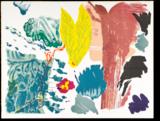Max Weiler *

(Hall, Tyrol, 1910–2001 Vienna)
‘Portrait of Karl Hiesmayr Sr.’, signed, dated Weiler 58, oil, egg tempera on canvas, laid down on panel, on masonite, 114 x 100 cm, (K)
Karl Hiesmayr (1885–1966), father of the architect Ernst Hiesmayr (1920–2006)
Full page colour illustration:
Max Weiler, Die innere Figur, published by Galerie Welz, 1989, p.135 – here date of execution given as 1958/59
...in all his stylistic transformations, Weiler consistently retained a similar form of perception. This included the physiognomy with its characteristic lineaments as well as what one could term the person´s outer bearing and inner mind-set. This is reflected in the observations which Vinzenz Oberhammer, himself the subject of a Weiler portrait and a knowledgeable art historian, had disclosed from his experiencee of sitting as a model. They indicate that Weiler strove to see the subject as caught up in their most characteristic movements as possible, in attitudes or postures which seemed to express their vitality. Oberhammer provides a most enlightening picture of Weiler’s approach to his models at the time: ‘The painter started with a settling-me-down, presenting-me-in-a-proper-light. Then the artist drew – straight onto the prepared canvas, in large strokes, taking only a short time, not even ten minutes – before immediately setting about painting. It was not necessary to be motionless. On the contrary. The painter always wanted a living model before him, wanted me to talk, narrate, he asked questions, all the time he tried to draw me into conversation, to irritate me, to provoke a disagreement… Finally the canvas was placed aside, naturally without me having seen it. At later sittings the previous work was peered at only quickly, and then entirely scraped off, before the brushes got busy again, starting to paint anew. This was repeated many times. The painter told me back then that it was necessary to do this. One must eventually know every stroke in the painting off by heart, the painting must appear as if perfectly applied alla prima, thus and only thus can vitality be achieved.’
Weiler himself stressed that a model’s static and confrontational pose in the studio, especially if the sitter was still largely unknown to him as a person, did not offer a satisfying basis for working. Thus the efforts involved in undertaking a portrait commission were not in establishing a physical likeness, but in capturing some essence of the depicted person´s nature…
From: Gottfried Boehm, Der Maler Max Weiler, Das Geistige in der Natur, published by Springer, 2001
Specialist: Mag. Elke Königseder
 Mag. Elke Königseder
Mag. Elke Königseder
+43-1-515 60-358
elke.koenigseder@dorotheum.at
11.06.2015 - 15:00
- Estimate:
-
EUR 60,000.- to EUR 80,000.-
Max Weiler *
(Hall, Tyrol, 1910–2001 Vienna)
‘Portrait of Karl Hiesmayr Sr.’, signed, dated Weiler 58, oil, egg tempera on canvas, laid down on panel, on masonite, 114 x 100 cm, (K)
Karl Hiesmayr (1885–1966), father of the architect Ernst Hiesmayr (1920–2006)
Full page colour illustration:
Max Weiler, Die innere Figur, published by Galerie Welz, 1989, p.135 – here date of execution given as 1958/59
...in all his stylistic transformations, Weiler consistently retained a similar form of perception. This included the physiognomy with its characteristic lineaments as well as what one could term the person´s outer bearing and inner mind-set. This is reflected in the observations which Vinzenz Oberhammer, himself the subject of a Weiler portrait and a knowledgeable art historian, had disclosed from his experiencee of sitting as a model. They indicate that Weiler strove to see the subject as caught up in their most characteristic movements as possible, in attitudes or postures which seemed to express their vitality. Oberhammer provides a most enlightening picture of Weiler’s approach to his models at the time: ‘The painter started with a settling-me-down, presenting-me-in-a-proper-light. Then the artist drew – straight onto the prepared canvas, in large strokes, taking only a short time, not even ten minutes – before immediately setting about painting. It was not necessary to be motionless. On the contrary. The painter always wanted a living model before him, wanted me to talk, narrate, he asked questions, all the time he tried to draw me into conversation, to irritate me, to provoke a disagreement… Finally the canvas was placed aside, naturally without me having seen it. At later sittings the previous work was peered at only quickly, and then entirely scraped off, before the brushes got busy again, starting to paint anew. This was repeated many times. The painter told me back then that it was necessary to do this. One must eventually know every stroke in the painting off by heart, the painting must appear as if perfectly applied alla prima, thus and only thus can vitality be achieved.’
Weiler himself stressed that a model’s static and confrontational pose in the studio, especially if the sitter was still largely unknown to him as a person, did not offer a satisfying basis for working. Thus the efforts involved in undertaking a portrait commission were not in establishing a physical likeness, but in capturing some essence of the depicted person´s nature…
From: Gottfried Boehm, Der Maler Max Weiler, Das Geistige in der Natur, published by Springer, 2001
Specialist: Mag. Elke Königseder
 Mag. Elke Königseder
Mag. Elke Königseder
+43-1-515 60-358
elke.koenigseder@dorotheum.at
|
Buyers hotline
Mon.-Fri.: 10.00am - 5.00pm
kundendienst@dorotheum.at +43 1 515 60 200 |
| Auction: | Contemporary Art, Part II |
| Auction type: | Saleroom auction |
| Date: | 11.06.2015 - 15:00 |
| Location: | Vienna | Palais Dorotheum |
| Exhibition: | 30.05. - 11.06.2015 |

